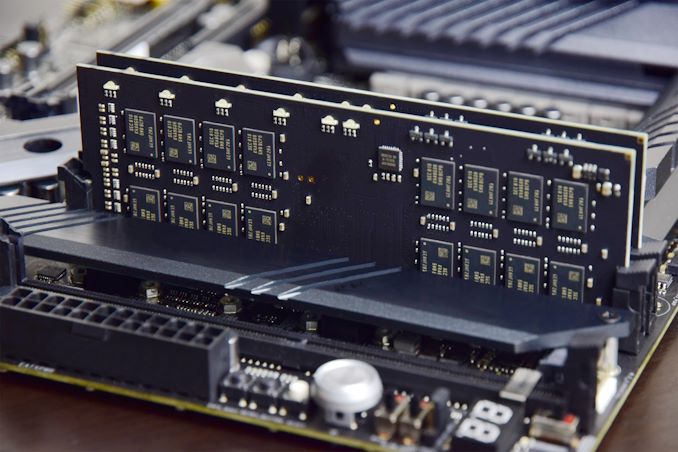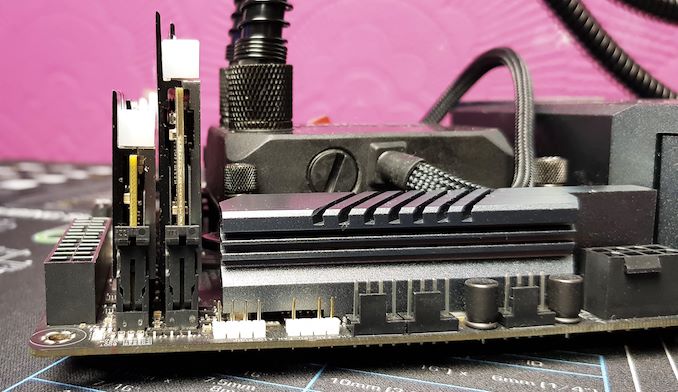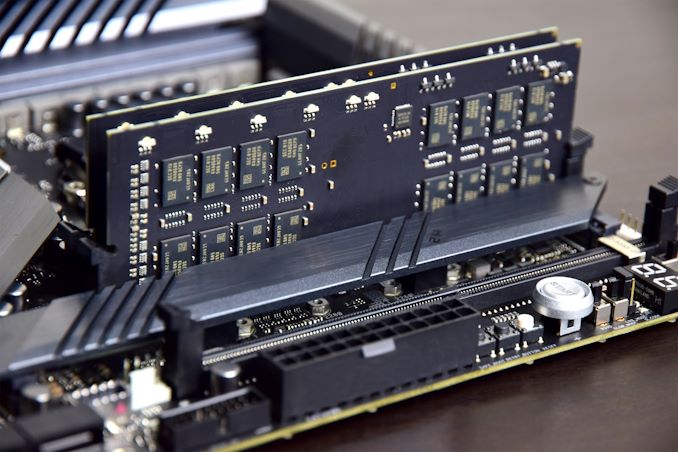Double Height DDR4: 32GB Modules from G.Skill and ZADAK Reviewed
by Ian Cutress & Gavin Bonshor on January 23, 2019 9:00 AM EST
Two memory module companies, G.Skill and ZADAK, have developed a new memory format with double capacity DDR4 memory. These new modules put the equivalent of two standard modules onto one PCB, making one memory module act like two. Both companies have introduced 2x32 GB kits. As a result, these memory modules are double the capacity over regular DDR4 memory, with the downside that they are also double the height. We have tested both of the available kits using this technique, both coming in at DDR4-3200: the G.Skill TridentZ RGB DC DDR4-3200 and the ZADAK Shield RGB DC DDR4-3200.
Double Height Memory?
One of the disadvantages of small form factor motherboards is that they only feature two memory slots. Most consumer DDR4 modules can have a maximum capacity of 16 GB per module, which for mini-ITX would mean a maximum capacity of 32 GB. For ATX motherboards, this usually means a maximum capacity of 64 GB. Users looking to build those small form factor systems have historically been capped to 32 GB - these new modules doubles that capacity to 64 GB.
There are currently three motherboards on the market validated for this new double height memory:
- ASUS ROG Maximus XI Apex (Z390)
- ASUS ROG Maximus XI Gene (Z390)
- ASUS ROG Strix Z390-I Gaming
These are all Z390 chipset motherboards, and thus applies to Intel's 8th Gen and 9th Gen processors. In this review we used an i7-8700K, and it didn't have any issues. We tested on some other motherboards from MSI and ASRock, however those systems did not post. It would appear that the memory has been developed in conjuction with concurrent validation with ASUS.

Left to Right: ZADAK Shield RGB DC, G.Skill TridentZ RGB DC,
G.Skill TridentZ RGB & Corsair Vengeance LPX
Each memory company is only offering a select number of kits, presumably due to the low catchment rate of the motherboards they are validated for, but also likely due to cost.
G.Skill is offering three different 'TridentZ RGB DC' memory kits, each 2x32 GB:
- G.Skill TridentZ RGB DC DDR4-3000 CL14
- G.Skill TridentZ RGB DC DDR4-3200 CL14
- G.Skill TridentZ RGB DC DDR4-3200 CL14 (looser secondary latencies)
ZADAK by contrast is offering five 'Shield RGB DC' memory kits, each 2x32 GB:
- ZADAK Shield RGB DC DDR4-2666 CL16
- ZADAK Shield RGB DC DDR4-3000 CL16
- ZADAK Shield RGB DC DDR4-3200 CL16
- ZADAK Shield RGB DC DDR4-3200 CL14
- ZADAK Shield RGB DC DDR4-3600 CL16
All of these kits (except ZADAK's DDR4-2666) have a rated voltage of 1.35 V. G.Skill's kits do not have associated MSRPs due to the way G.Skill operates, however ZADAK has shared that their memory kits will start from an MSRP of $800.
The benefit of dense(r) memory is thatmotherboards can double up on maximum capacity without needing four memory slots. All three motherboards listed, the Apex, Gene, and the Z390-I Gaming, only have two memory slots which makes them ideal targets, even though only one is mini-ITX and the other two could have had four memory slots in place. The reason why only these ASUS motherboards are supported at this time is due to the collaboration between the companies: ZADAK says the modules were 'co-developed', but failed to go into detail about who designed what. Nonetheless, these modules are ASUS exclusive for the time being.
Double Height: Cooler Selection
Using memory that is double the height of a normal module, certain other restrictions come into play: namely the CPU cooler being used has less room to exist.
The almost universal intention in this environment, unless a low powered CPU is used, is for a liquid cooler to be in play.
Under The Heatsinks
We'll go into more detail on the specific kits over the page, but both memory modules work in a similar fashion.
Using 8 Gb Samsung B-die chips, a normal 16 GB module would have 16 of them to make it up to capacity. For these modules, to reach 32 GB per module, there are 32 x 8 gigabit chips. These are split into two ranks of sixteen chips, and act as if there are two memory modules on the same channel. Modern mainstream processors support 'two DIMMs per channel', meaning two memory modules per channel, which is why we see motherboards for dual channel processors have a total of four slots. By putting two modules onto one PCB, only one slot is needed to hit 'two DIMMs per channel'.
One would assume the signalling would be different, however within the same channel, a normal set of memory modules would use the same traces and either (a) daisy chain, or (b) split near the end in order to support both simulateously. There are stability advantages to the (b) method, known as T-Topology, however it is often more difficult to do. Either way, because two memory modules on the same channel do not need separate motherboard traces, that is what makes these modules possible. There are some additional fine tuning elements to the system as well, as with all memory.
Ultimately any memory vendor's chips could have been used, but both G.Skill and ZADAK have gone with Samsung B-die, which are known for being good overclocking-focused memory. It likely also helps that the optimizations for one company's kit also helped with the second, as different ICs would have different requirements in the firmware.
Ultimately with this review, we want to answer the following questions:
- Is there any performance difference against normal 16GB modules, and
- How is the power draw affected?
The goal for both answers should be negative: we shouldn't expect any performance difference and no power difference. We also do some overclocking to see if they can be pushed harder even in this form factor.
Test Bed and Methodology
| Test Setup | |||
| Processor | Intel i7-8700K, 95W, $359 / 1ku 6 Cores, 12 Threads, 3.7 GHz (4.7 GHz Turbo) |
||
| Motherboard | ASUS ROG Strix Z390-I Gaming (BIOS Version 1003) | ||
| Cooling | Corsair H100i V2 | ||
| Power Supply | Thermaltake Toughpower Grand 1200W Gold PSU | ||
| Memory Tested | 2x32GB G.Skill TridentZ DC RGB DDR4-3200 CL14 (1.35 V) 2x32GB ZADAK Shield DC RGB DDR4-3200 CL14 (1.35 V) 2x16GB G.Skill TridentZ RGB DDR4-3200 CL14 (1.35 V) 2x16GB Corsair Vengeance LPX DDR4-2400 CL14 (1.2 V) 2x8GB TeamGroup Night Hawk RGB DDR4-3000 CL16 (1.35 V) |
||
| Video Card | ASUS GTX 980 STRIX (1178/1279 Boost) | ||
| Hard Drive | Crucial MX300 1TB | ||
| Case | Open Test Bed | ||
| Operating System | Windows 10 RS3 inc. Spectre/Meltdown Patches | ||
New Test Suite: Spectre and Meltdown Hardened
Our motherboard benchmarking suite which includes our short form CPU performance tests and gaming tests were selected in conjunction with our new 2019 bench suite. Our test bench OS has been updated with drivers, newer software and as with our CPU testing updates, also includes Spectre and Meltdown patches.
Pages In This Review
- Double Capacity, Double Height RAM [this page]
- G.Skill TridentZ RGB DC Overview: Analysis of the Board Components
- ZADAK Shield RGB DC Aura2 Overview : Looking that the non-hardware portion
- CPU Performance
- Gaming Performance
- Power Analysis
- Overclocking Performance
- Conclusion












50 Comments
View All Comments
Alim345 - Wednesday, January 23, 2019 - link
It’s not clear whether it is possible to use four sticks. Probably it is not since those sticks replicate what should happen in motherboard.Targon - Thursday, January 24, 2019 - link
Much of that would be a function of the chipset/BIOS and the memory controller which is on the CPU these days. These double height modules can't directly talk to the memory controller as if they are two modules, because the memory slots themselves and how they talk to the chipset/memory controller/CPU are not different.That is why I wanted to see at least an attempt to get these to work with a socket AM4 system and see how they show up. Going from 1T or 2T to 2T or 4T for the memory is probably the issue, and if the chipset would even allow it. Asking Asus if they have plans to allow DDR4 to run with a 4T command rate on more boards would be worth the call.
nevcairiel - Wednesday, January 23, 2019 - link
Since one of those DIMMs basically acts like two DIMMs, you probably cannot use two of them on the same channel, since that would require supporting 4 DIMMs on the same channel.Targon - Thursday, January 24, 2019 - link
I don't think it works that way. Yes, internally each one is working as if it was two, but how the module talks to the BIOS/chipset/processor is the big question. Does the BIOS need to support a 4T command rate on the memory for these to work, and if so, that explains why support is limited.Bp_968 - Thursday, January 24, 2019 - link
He explained in the article that the way memory channels are handled that the traces are daisy chained or combined. These dimms act as 2 dimms slapped onto one card and won't work stacked 2 too a channel (because then you'd have 4 dimms on a channel).Above and beyond that you also have the fact that now 32GB modules exist which render these far less useful. There are very very few scenarios where you'd want 128GB of ram and not want it to be ECC RAM. Any sort of server and many workstation tasks I'd much prefer to use ECC ram instead.
yuhong - Wednesday, January 23, 2019 - link
Even Intel don't usually update ARK or the datasheet.alpha754293 - Wednesday, January 23, 2019 - link
Maybe I'm missinng something here - but I don't understand why people just don't get 32 GB DDR4-2666 ECC Registered DIMMS like this one (https://www.newegg.com/Product/Product.aspx?Item=N... and be done with it?It's going to run about the same price and they can just overclock it.
Wixman666 - Wednesday, January 23, 2019 - link
Because most boards don't run ECC memory. These are a niche product to get 64GB on boards that only have 2 slots. Lots of memory doesn't overclock well. You're making assumptions with your statement that are completely off base.CheapSushi - Thursday, January 24, 2019 - link
Does that mean ECC RAM will NOT WORK AT ALL or just the ECC portion, soft error correcting, won't work but it'll show up like regular RAM?alpha754293 - Thursday, January 24, 2019 - link
I've used ECC memory on consumer grade boards. All that happens is that the ECC part of the ECC, Registered RAM gets disabled and the rest of the DIMM module functions like a UDIMM instead of a RDIMM."You're making assumptions with your statement that are completely off base."
Yes! Which is why I literally said: "Maybe I'm missinng something here - but I don't understand why people just don't get 32 GB DDR4-2666 ECC Registered DIMMS like this one (https://www.newegg.com/Product/Product.aspx?Item=N... and be done with it?"
Lots of memory don't overclock well is just a broad and generic statement that can also be applied to these modules as well.
The fact of the matter is that DDR4-3000 and DDR4-3200 modules ARE overclocked by default anyways because those speeds aren't part of the JEDEC JESD79-4 spec (p.163).
Here is a 32 GB module from Micron Technology, DDR4-3200, ECC Registered: https://www.ebay.com/itm/Micron-MTA36ASF4G72PZ-3G2...
The point being that a) they exist already and b) you should be able to disable the ECC, registered capabilities of these DIMMs. (I've never had a consumer grade board that didn't know how to ignore the ECC registered capabilities of RDIMMs.)
In other words, you can already do this with existing modules that you can buy, at those speeds, "second" hand (which tells you a little bit about the maturity of the tech).